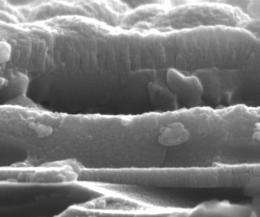Inkjet printing could change the face of solar energy industry

Inkjet printers, a low-cost technology that in recent decades has revolutionized home and small office printing, may soon offer similar benefits for the future of solar energy.
Engineers at Oregon State University have discovered a way for the first time to create successful "CIGS" solar devices with inkjet printing, in work that reduces raw material waste by 90 percent and will significantly lower the cost of producing solar energy cells with some very promising compounds.
High performing, rapidly produced, ultra-low cost, thin film solar electronics should be possible, scientists said.
The findings have been published in Solar Energy Materials and Solar Cells, a professional journal, and a patent applied for on the discovery. Further research is needed to increase the efficiency of the cell, but the work could lead to a whole new generation of solar energy technology, researchers say.
"This is very promising and could be an important new technology to add to the solar energy field," said Chih-hung Chang, an OSU professor in the School of Chemical, Biological and Environmental Engineering. "Until now no one had been able to create working CIGS solar devices with inkjet technology."
Part of the advantage of this approach, Chang said, is a dramatic reduction in wasted material. Instead of depositing chemical compounds on a substrate with a more expensive vapor phase deposition – wasting most of the material in the process – inkjet technology could be used to create precise patterning with very low waste.
"Some of the materials we want to work with for the most advanced solar cells, such as indium, are relatively expensive," Chang said. "If that's what you're using you can't really afford to waste it, and the inkjet approach almost eliminates the waste."
One of the most promising compounds and the focus of the current study is called chalcopyrite, or "CIGS" for the copper, indium, gallium and selenium elements of which it's composed. CIGS has extraordinary solar efficiency – a layer of chalcopyrite one or two microns thick has the ability to capture the energy from photons about as efficiently as a 50-micron-thick layer made with silicon.
In the new findings, researchers were able to create an ink that could print chalcopyrite onto substrates with an inkjet approach, with a power conversion efficiency of about 5 percent. The OSU researchers say that with continued research they should be able to achieve an efficiency of about 12 percent, which would make a commercially viable solar cell.
In related work, being done in collaboration with Greg Herman, an OSU associate professor of chemical engineering, the engineers are studying other compounds that might also be used with inkjet technology, and cost even less.
Some approaches to producing solar cells are time consuming, or require expensive vacuum systems or toxic chemicals. OSU experts are working to eliminate some of those roadblocks and create much less costly solar technology that is also more environmentally friendly. New jobs and industries in the Pacific Northwest could evolve from such initiatives, they say.
If costs can be reduced enough and other hurdles breached, it might even be possible to create solar cells that could be built directly into roofing materials, scientists say, opening a huge new potential for solar energy.
"In summary, a simple, fast, and direct-write, solution-based deposition process is developed for the fabrication of high quality CIGS solar cells," the researchers wrote in their conclusion. "Safe, cheap, and air-stable inks can be prepared easily by controlling the composition of low-cost metal salt precursors at a molecular level."
Provided by Oregon State University


















